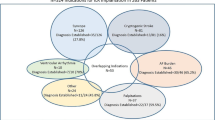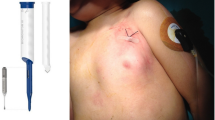Abstract
Purpose
Implantable loop recorders (ILRs) are increasingly being used for ambulatory electrocardiography. We sought to evaluate ILR indications, diagnostic yield, ILR-guided interventions, and complications in two Canadian centers.
Methods
This was a retrospective study using electronic medical records to identify ILR implants at Queen’s University and the University of Manitoba. Information was collected on patient characteristics, medications, indication for implant, results of prior investigations, diagnostic outcome, and subsequent management.
Results
A total of 540 patients were identified; 386 had completed monitoring at time of analysis. Forty patients were lost to follow-up. Indications were unexplained syncope 84.8%, palpitations 12.8%, and suspected atrial fibrillation 11.7%. For syncope, ILRs documented arrhythmia or conduction disorder in 46%. Most common conditions were asystole/sinus pause (22%), complete heart block (10.4%), and atrial fibrillation (AF) (6.9%). After ILR diagnosis, 39.9% of implanted patients received pacemaker/ICD and 2.7% underwent catheter ablation. For palpitations, ILRs documented arrhythmia or conduction disorder in 60.4%. Most common conditions were AVNRT, AF, complete heart block, and ventricular tachycardia. After diagnosis, 25% underwent catheter ablation and 22.9% received pacemaker/ICD. For suspected AF, AF was diagnosed in 40%. Complications were observed in 3.3% of implanted patients: implant site infection 1.5%, non-infectious implant site pain requiring device removal or pocket revision 1.5%, 0.2% hypertrophic scar, and 0.2% device malfunction.
Conclusions
An ILR has excellent diagnostic yield for syncope, palpitations, and suspected AF, and a considerable proportion of patients undergo ILR-directed interventions following monitoring. ILR implantation is a low-risk procedure.


Similar content being viewed by others
References
Soteriades ES, Evans JC, Larson MG, Chen MH, Chen L, Benjamin EJ, et al. Incidence and prognosis of syncope. N Engl J Med. 2002;347:878–85. https://doi.org/10.1056/NEJMoa012407.
Kapoor WN, Peterson J, Wieand HS, Karpf M. Diagnostic and prognostic implications of recurrences in patients with syncope. Am J Med. 1987;83:700–8.
Linzer M, Pontinen M, Gold DT, Divine GW, Felder A, Brooks WB. Impairment of physical and psychosocial function in recurrent syncope. J Clin Epidemiol. 1991;44:1037–43.
van Dijk N, Sprangers MA, Boer KR, Colman N, Wieling W, Linzer M. Quality of life within one year following presentation after transient loss of consciousness. Am J Cardiol. 2007;100:672–6. https://doi.org/10.1016/j.amjcard.2007.03.085.
Farwell DJ, Freemantle N, Sulke N. The clinical impact of implantable loop recorders in patients with syncope. Eur Heart J. 2005;27:351–6. https://doi.org/10.1093/eurheartj/ehi602.
Edvardsson N, Frykman V, van Mechelen R, Mitro P, Mohii-Oskarsson A, Pasquié J-L, et al. Use of an implantable loop recorder to increase the diagnostic yield in unexplained syncope: results from the PICTURE registry. Europace. 2011;13:262–9. https://doi.org/10.1093/europace/euq418.
Sulke N, Sugihara C, Hong P, Patel N, Freemantle N. The benefit of a remotely monitored implantable loop recorder as a first line investigation in unexplained syncope: the EaSyAS II trial. Europace. 2016;18:912–8. https://doi.org/10.1093/europace/euv228.
Raviele A, Giada F, Bergfeldt L, Blanc JJ, Blomstrom-Lundqvist C, Mont L, et al. Management of patients with palpitations: a position paper from the European Heart Rhythm Association. Europace. 2011;13:920–34. https://doi.org/10.1093/europace/eur130.
Giada F, Gulizia M, Francese M, Croci F, Santangelo L, Santomauro M, et al. Recurrent unexplained palpitations (RUP) study comparison of implantable loop recorder versus conventional diagnostic strategy. J Am Coll Cardiol. 2007;49:1951–6. https://doi.org/10.1016/j.jacc.2007.02.036.
Klemm HU, Ventura R, Rostock T, Brandstrup B, Risius T, Meinertz T, et al. Correlation of symptoms to ECG diagnosis following atrial fibrillation ablation. J Cardiovasc Electrophysiol. 2006;17:146–50. https://doi.org/10.1111/j.1540-8167.2005.00288.x.
Manganiello S, Anselmino M, Amellone C, Pelissero E, Giuggia M, Trapana G, et al. Symptomatic and asymptomatic long-term recurrences following transcatheter atrial fibrillation ablation. Pacing Clin Electrophysiol. 2014;37:697–702. https://doi.org/10.1111/pace.12387.
Glotzer TV, Daoud EG, Wyse DG, Singer DE, Ezekowitz MD, Hilker C, et al. The relationship between daily atrial tachyarrhythmia burden from implantable device diagnostics and stroke risk: the TRENDS study. Circ Arrhythm Electrophysiol. 2009;2:474–80. https://doi.org/10.1161/CIRCEP.109.849638.
Boriani G, Glotzer TV, Santini M, West TM, De Melis M, Sepsi M, et al. Device-detected atrial fibrillation and risk for stroke: an analysis of 10,000 patients from the SOS AF project (Stroke preventiOn Strategies based on Atrial Fibrillation information from implanted devices). Eur Heart J. 2014;35:508–16. https://doi.org/10.1093/eurheartj/eht491.
Moya A, Sutton R, Ammirati F, Blanc J-J, Brignole M, Dahm JB, et al. Guidelines for the diagnosis and management of syncope (version 2009). Eur Heart J. 2009;30:2631–71. https://doi.org/10.1093/eurheartj/ehp298.
Shen W-K, Sheldon RS, Benditt DG, Cohen MI, Forman DE, Goldberger ZD, et al. 2017 ACC/AHA/HRS guideline for the evaluation and management of patients with syncope: executive summary: a report of the American College of Cardiology/American Heart Association Task Force on clinical practice guidelines, and the Heart Rhythm Society 2017. https://doi.org/10.1016/j.hrthm.2017.03.005.
Brignole M, Vardas P, Hoffman E, Huikuri H, Moya A, Ricci R, et al. Indications for the use of diagnostic implantable and external ECG loop recorders. Europace. 2009;11:671–87. https://doi.org/10.1093/europace/eup097.
Camm AJ, Kirchhof P, Lip GYH, Schotten U, Savelieva I, Ernst S, et al. Guidelines for the management of atrial fibrillation: the task force for the management of atrial fibrillation of the European Society of Cardiology (ESC). Europace. 2010;12:1360–420. https://doi.org/10.1093/europace/euq350.
Camm AJ. The role of continuous monitoring in atrial fibrillation management. Arrhythmia Electrophysiol Rev. 2014;3:48–50. https://doi.org/10.15420/aer.2011.3.1.48.
Moya A, Brignole M, Menozzi C, Garcia-Civera R, Tognarini S, Mont L, et al. Mechanism of syncope in patients with isolated syncope and in patients with tilt-positive syncope. Circulation. 2001;104:1261–7.
Lacunza-Ruiz FJ, Moya-Mitjans A, Martínez-Alday J, Barón-Esquivias G, Ruiz-Granell R, Rivas-Gándara N, et al. Implantable loop recorder allows an etiologic diagnosis in one-third of patients. Circ J. 2013;77:2535–41. https://doi.org/10.1253/circj.CJ-13-0201.
Silveira I, Sousa MJ, Antunes N, Silva V, Roque C, Pinheiro-Vieira A, et al. Efficacy and safety of implantable loop recorder: experience of a center. J Atr Fibrillation. 2016;9:1425. https://doi.org/10.4022/jafib.1425.
Inamdar V, Mehta S, Juang G, Cohen T. The utility of implantable loop recorders for diagnosing unexplained syncope in 100 consecutive patients: five-year, single-center experience. J Invasive Cardiol. 2006;18:313–5.
Entem FR, Enriquez SG, Cobo M, Expósito V, Llano M, Ruiz M, et al. Utility of implantable loop recorders for diagnosing unexplained syncope in clinical practice. Clin Cardiol. 2009;32:28–31. https://doi.org/10.1002/clc.20342.
Podoleanu C, DaCosta A, Defaye P, Taieb J, Galley D, Bru P, et al. Early use of an implantable loop recorder in syncope evaluation: a randomized study in the context of the French healthcare system (FRESH study). Arch Cardiovasc Dis. 2014;107:546–52. https://doi.org/10.1016/j.acvd.2014.05.009.
Furukuwa T, Maggi R, Bertolone C, Fontana D, Brignole M. Additional diagnostic value of very prolonged observation by implantable loop recorder in patients with unexplained syncope. J Cardiovasc Electrophysiol. 2012;23:67–71. https://doi.org/10.1111/j.1540-8167.2011.02133.x.
Merlos P, Rumiz E, Ruiz-Granell R, Martinez A, Izquierdo MT, Ferrero A, et al. Outcome of patients with syncope beyond the implantable loop recorder. Europace. 2013;15:122–6. https://doi.org/10.1093/europace/eus264.
Maggi R, Rafanelli M, Ceccofiglio A, Solari D, Brignole M, Ungar A, et al. Additional diagnostic value of implantable loop recorder in patients with initial diagnosis of real or apparent transient loss of consciousness of uncertain origin. Europace. 2014;16:1226–30. https://doi.org/10.1093/europace/euu051.
Bhangu J, McMahon CG, Hall P, Bennett K, Rice C, Crean P, et al. Long-term cardiac monitoring in older adults with unexplained falls and syncope. Heart. 2016;102:681–6. https://doi.org/10.1136/heartjnl-2015-308706.
Sciaraffia E, Chen J, Hocini M, Larsen TB, Potpara T, Blomstrom-Lundqvist C. Use of event recorders and loop recorders in clinical practice: results of the European Heart Rhythm Association Survey. Europace. 2014;16:1384–6. https://doi.org/10.1093/europace/euu222.
Zimetbaum PJ, Kim KY, Josephson ME, Goldberger AL, Cohen DJ. Diagnostic yield and optimal duration of continuous-loop event monitoring for the diagnosis of palpitations. A cost-effectiveness analysis. Ann Intern Med. 1998;128:890–5.
Attanasio P, Huemer M, Loehr L, Parwani AS, Boldt L-H, Haverkamp W, et al. Use of a patient-activated event recording system in patients with tachycardic palpitations: how long to follow up? Ann Noninvasive Electrocardiol. 2015;20:566–9. https://doi.org/10.1111/anec.12301.
Locati ET, Vecchi AM, Vargiu S, Cattafi G, Lunati M. Role of extended external loop recorders for the diagnosis of unexplained syncope, pre-syncope, and sustained palpitations. Europace. 2014;16:914–22. https://doi.org/10.1093/europace/eut337.
Baranchuk A. Sleep apnea, cardiac arrhythmias, and conduction disorders. J Electrocardiol. 2012;45:508–12. https://doi.org/10.1016/j.jelectrocard.2012.03.003.
Drew D, Qaddoura A, Baranchuk A. The relationship between obstructive sleep apnea and atrial fibrillation in special patient populations. Expert Rev Cardiovasc Ther. 2014;12:1337–48. https://doi.org/10.1586/14779072.2014.969713.
Afzal MR, Gunda S, Waheed S, Sehar N, Maybrook RJ, Dawn B, et al. Role of outpatient cardiac rhythm monitoring in cryptogenic stroke: a systematic review and meta-analysis. Pacing Clin Electrophysiol. 2015;38:1236–45. https://doi.org/10.1111/pace.12688.
Yang P, Pu L, Yang L, Li F, Luo Z, Guo T, et al. Value of implantable loop recorders in monitoring efficacy of radiofrequency catheter ablation in atrial fibrillation. Med Sci Monit. 2016;22:2846–51.
Pokushalov E, Romanov A, Corbucci G, Artyomenko S, Turov A, Shirokova N, et al. Ablation of paroxysmal and persistent atrial fibrillation: 1-year follow-up through continuous subcutaneous monitoring. J Cardiovasc Electrophysiol. 2011;22:369–75. https://doi.org/10.1111/j.1540-8167.2010.01923.x.
Hanke T, Charitos EI, Stierle U, Karluss A, Kraatz E, Graf B, et al. Twenty-four-hour Holter monitor follow-up does not provide accurate heart rhythm status after surgical atrial fibrillation ablation therapy: up to 12 months experience with a novel permanently implantable heart rhythm monitor device. Circulation. 2009;120:S177–84. https://doi.org/10.1161/CIRCULATIONAHA.108.838474.
Pokushalov E, Romanov A, Corbucci G, Artyomenko S, Turov A, Shirokova N, et al. Use of an implantable monitor to detect arrhythmia recurrences and select patients for early repeat catheter ablation for atrial fibrillation: a pilot study. Circ Arrhythm Electrophysiol. 2011;4:823–31. https://doi.org/10.1161/CIRCEP.111.964809.
Wong GR, Lau DH, Middeldorp ME, Harrington JA, Stolcman S, Wilson L, et al. Feasibility and safety of Reveal LINQ insertion in a sterile procedure room versus electrophysiology laboratory. Int J Cardiol. 2016;223:13–7. https://doi.org/10.1016/j.ijcard.2016.08.113.
Drew D, Borici-Mazi R, Baranchuk A. Implantable loop recorder hypersensitivity. J Innov Card Rhythm Manag. 2015;6:2109–11.
Funding
This research did not receive any specific grant from funding agencies in the public, commercial or not-for-profit sectors.
Author information
Authors and Affiliations
Corresponding author
Ethics declarations
Conflict of Interest
The authors declare that they have no conflict of interest.
Ethical Approval
All procedures performed in studies involving human participants were in accordance with the ethical standards of the institutional research committee and with the 1964 Helsinki declaration and its later amendments or comparable ethical standards. For this type of study formal consent is not required.
Rights and permissions
About this article
Cite this article
Ibrahim, O.A., Drew, D., Hayes, C.J. et al. Implantable loop recorders in the real world: a study of two Canadian centers. J Interv Card Electrophysiol 50, 179–185 (2017). https://doi.org/10.1007/s10840-017-0294-y
Received:
Accepted:
Published:
Issue Date:
DOI: https://doi.org/10.1007/s10840-017-0294-y




